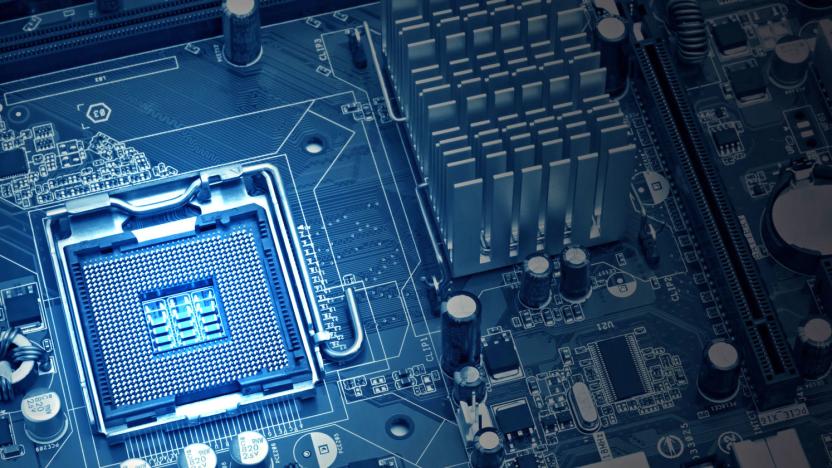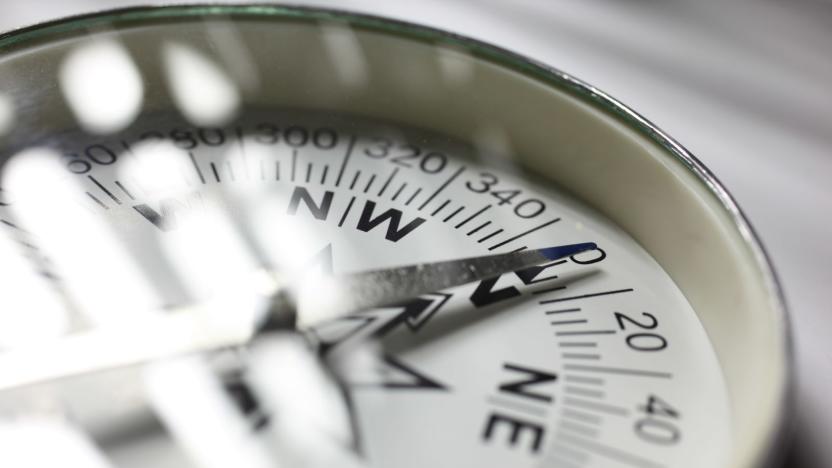magnets
Latest

'Unprecedented' 3D magnetic interactions could change computing
The field of spintronics, or spin electronics, uses an electron's spin and its magnetic movement to encode instructions and other data. It's sometimes seen as an alternative to electronics, which relies on the electron's charge to encode data. While spintronics has the potential to increase data processing speeds, boost storage capacity and offer increased data resilience, it's been limited because physicists could only move the electrons -- or tiny magnetic particles -- around a single atomic layer. Now, researchers have found a way to move information from magnets in one layer to magnets in another. They hope the discovery will lead to new possibilities for data storage and computing.

Scientists have just created the thinnest magnet ever
In 2004, scientists made headlines when they constructed graphene, a layer of carbon that is so thin it's considered to be two-dimensional -- just one atom thick. Since then, 2D insulators, semiconductors and superconductors have followed, and now they may have made another breakthrough. In the latest issue of Nature, scientists report that they have created the first 2D magnet.

Computer models help form new magnetic materials
Magnetic materials are extremely difficult to find. They're rare in nature, and creating one in the lab usually involves both a lot of experimentation and a little luck. Duke University, however, has found a way to take the mystery out of the process: its researchers have used computer modelling to help generate two new kinds of magnetic materials. The models whittled down the potential atomic structures from a whopping 236,115 combinations to just 14 candidates by subjecting the structures to increasingly tougher tests. How stable are they? Do they have a "magnetic moment" that determines the strength of their reaction to an outside magnetic field? After that, it was just a matter of synthesizing the few remaining materials to see how well they worked in real life.

DARPA has laid the groundwork for thought-powered prosthetics
New research from the government's mad science wing, DARPA, could make life an awful lot easier for people who use prosthetic limbs. You see, DAPRA has devised what it calls the "Atomic Magnetometer for Biological Imaging in Earth's Native Terrain." Or, "AMBIIENT" if you're into the whole brevity thing.

ICYMI: Reptile robots in the wild
Today on In Case You Missed It: BBC One's nature show, "Spy in the Wild," partnered with a robotics division in order to design and produce two remote-controlled robot reptiles. Using bio-informed robotics, the team closely reproduced the creature's movements in the robots, which were constructed with motors, aluminum, carbon fiber and latex waterproof suits. The robo-reptiles -- a crocodile model and a monitor lizard version -- will be used to study real life animals up-and-close.

Doctors can now sift bacteria from your blood using magnets
Sepsis, or blood poisoning, is no joke. More than half the people who contract the condition end up in the morgue. The conventional treatment involve the liberal application of antibiotics at the first sign of infection, though as we discovered on an American pig farm Wednesday, even our best meds may no longer be enough. And that's where the magnets come in.

Dear Veronica: How tech works around magnets!
#fivemin-widget-blogsmith-image-411425{display:none;} .cke_show_borders #fivemin-widget-blogsmith-image-411425, #postcontentcontainer #fivemin-widget-blogsmith-image-411425{width:570px;display:block;} try{document.getElementById("fivemin-widget-blogsmith-image-411425").style.display="none";}catch(e){} This week on the show, we look into how technology has shielded itself from the dangers of magnets. But we also look into a far more serious thread: chronic "likers" on social media. What does one do when things get a little awkward? To wrap things up, I sing a few tunes to Siri to find out if she'll work better than usual. I apologize in advance -- I'm much better at karaoke after a few cocktails, I swear!

Deranged magnet shoes claim to let you walk on the moon
It's one of those ideas that seems inspired at 3am after several beverages too many, but insane in the cold, harsh light of the following morning. Look, yeah, why not create a shoe that's got two sets of repelling magnets pointed at each other, so that the wearer will feel, right, as if they're floating on air, yeah? That's the concept behind 2016 MoonWalker, an Indiegogo campaign for shoes that claim to make you feel as if you're defying gravity with every step.

Researchers confirm Humpty Dumpty really can't be put together again
Researchers at the Federal University of ABC, in Brazil, have made a major breakthrough: they've confirmed that thermodynamic processes cannot be reversed, even in a quantum system. This revelation not only explains a fundamental aspect of our universe but could also influence how quantum computing systems are designed.

Self-assembling gauss gun idea would heal patients from the inside
A research team from the University of Houston and Boston Children's Hospital debuted a novel new approach to internal medicine: using a swarm of tiny, noninvasive robots as a gauss gun to shoot medicine or clot-busting needles directly at the afflicted tissue. Much like rail guns, gauss guns rely on a series of magnets to accelerate objects -- the difference being that these guns transfer force through the magnets themselves, converting the stored magnetic energy into kinetic.

Lexus video teases a 'real' magnetic hoverboard
Yes, we know - it's 2015, the year Marty jumped to in Back to the Future 2 and you still don't have a hoverboard. Right on time, Lexus has presented the latest example from its "Amazing in Motion" series of video spectacles: the Lexus Hoverboard. As you can see in the video after the break, it certainly appears to hover, and smoke, but no one actually hops on the magnetically-levitating device for a ride. Gizmodo heard from the carmaker that this project has been in development over the last 18 months, but couldn't get more specific info on how it works.

This foldable drone origamis itself and dissolves when done
MIT recently unveiled -- or rather, unfurled -- an unusual drone specimen. The tiny robot weighs a third of a gram and is just 1.7 cm long. It starts its existence as a flat, paper or polystyrene wafer. When activated with a small heat source, the drone folds itself up into the complex shape you see above and can begin moving (or swimming!) at a rate of 3 cm/sec.

iFixit explains how Apple's new MacBook haptic trackpad works
Apple's new range of MacBooks have something particularly new inside them: the Force Touch trackpad. No longer hinged like previous Apple laptops, the new touchpad houses a "Haptic Engine", outputting tactile feedback that will let you "feel" what's happening on-screen. iFixit's taken a closer look at how Apple did it, and while the trackpad is no longer hinged, there are now four spring mounts underneath. That haptic engine? A load of wires coiled around a magnetic core, which makes that all important vibrational feedback.

Researchers deliver encoded messages and data through your smartphone compass
NFC, Bluetooth, WiFi, mobile data, plain 'ole voice calls. Your phone has no shortage of ways to connect with things, but that hasn't stopped a group of Finnish scientists finding a way to communicate through your smartphone's built-in compass. Just because they could. While NFC can send data up to 20 centimeters away, these magnetic messages diffuse within a few centimeters -- this limitation could help make wireless payments more secure. Researcher Kostakos Vassilis, talking to New Scientist , said that this magnetic messaging system would mean the phone exchanges nothing until it is within two centimeters (roughly 0.8 inches) of the payment terminal. When the devices get close enough, a secure code could then be delivered through a magnetic field, activating a wireless payment app or NFC connection. Through the data encoded through a varying magnetic field, the team at the University of Oulu in Finland were able to deliver web addresses (and even an anachronistic MIDI music file) from an electromagnet to the phone. At 40 bits per second, heavy data lifting isn't going to happen here, but the group says it'll outline more uses later this summer. We're hoping it'll involve Wooly Willy.

High-speed maglev toys are coming in 2015
Takara Tomy promised us that maglev technology would make its way to playsets next year, when we spoke at this year's Tokyo Toy Show. It had two very different toys on hand, one a train that the company claims can reach up to 600 KPH (relative to its scale, at least). To our untrained eyes, all we can say is it seemed pretty damn fast. The train contains its own magnet that levitates it off the plastic track, which is itself laced with magnets. The resulting air cushion reduces one of the biggest buzzkills in all of physics: friction. Since the magnetic field produces both an upward and forward thrust, there's no need for a set of Hot Wheels-style accelerators that manually hurl your car around the track.

Watch a tiny, magnetically powered robot construction crew go to work
A robot doesn't have to big, powerful and terrifying to be worthwhile, and many people are working on miniature machines that are just as cool. Some of these endeavors show promise in medicine, but there are plenty of potential uses for microbots, especially when you can persuade a swarm of them to work together. Research outfit SRI reckons tiny automatons have a bright future in manufacturing, thanks to its new method for precisely controlling individuals within a larger group. You see, one of the best ways of propelling and controlling microbots is by using magnets. and it's because there's no need for an on-board power source that we can make 'em so small. This poses a problem, however, as a pack of bots will all respond to a magnetic field in the same way, making it hard to give anything but a blanket order.

Japanese bridge inspection robot has magnetic wheels, shuffles up walls
Most wall-climbing robots rely on advanced forms of suction to keep them adhered to a flat surface, but Japan's latest wall crawler employs a different method: magnets. Hailing from the Osaka City University Graduate School of Engineering, BIREM (which stands for Bridge Inspection Robot Equipping Magnets) is designed to -- as the name suggests -- inspect bridges. Riding four spoked wheels adorned with eight magnets a piece, it can creep across metal girders at a rate of 7.8 inches per second. Its flexible midsection promises to give it an edge over uneven structures, and its creators hope that it will eventually lower infrastructure inspection costs. You won't see it crawling across the Golden Gate any time soon, however -- the team doesn't expect to commercialize it for another three years.

The 12 Days of iMas, Day 2: Some refrigerator magnets to take you back in time
Today is the second day of a 12-day feature where we'll show you the strangest Apple-flavored gifts we can find. Check out the previous days here: Day 1 Day 2: iOS 6 fridge magnets, because you know you don't deserve iOS 7 It really would make sense if these 18 magnets, modeled after the iPhone's instantly recognizable default app icons, were designed to resemble the ones from the current iOS generation... but they're not. Deal with it. Why would anyone want even one of these tiny metal magnets, let alone all 18 of them? I have no idea. Maybe they have a tiny black or white fridge that they want to make look like an iPhone. Maybe they're so in love with iOS 6 that they just can't stand to let the skeuomorphic beauty of those apps die. Or maybe they have an iPhone and you can't think of anything else to cram in the stocking of a loved one. All of these are valid reasons, and for less than US$4, it's hard to bet against these little guys.

Panasonic preps SD cards that survive heat, water and X-rays, will probably outlast you
Much ado has been made of weather-resistant cameras, but it's all a moot point if the memory card dies, isn't it? Panasonic wants that level of survivability in its SDHC and SDXC cards, and its new UHS-I-level SDAB and SDUB lines are tested for the kind of abuse that could see the camera give up the ghost first. The cards can take the kinds of punishment that we often associate with rugged gear, such as temperatures from -13F to 185F, immersion in 3.3 feet of water for half an hour and the usual steep drops. It's beyond this that the resistance levels become truly exotic: the cards are also built to survive zaps of electricity, proximity to magnets and exposure to X-rays. If it all becomes too much to bear, the design will even fuse on the inside to prevent fire burning the card from within. Those who like what they see will only have to decide whether or not they want the SDAB range's 95MB/s read speeds and 80MB/s writes or are willing to settle for the SDUB line's respective 90MB/s and 45MB/s transfers. We have yet to see if or when the SD cards cross the Pacific after their September 8th launch in Japan, although we hope so -- with that kind of extra-tough design, our photos are more likely to endure than we will.

Microsoft applies to patent MagSafe-like magnetic power and data coupling
Microsoft has applied to patent a magnetic power and data coupling that's similar to the power-only MagSafe. Using the technology, the unit would snap onto the base of your phone (in the example) in either direction, pushing juice and information without the needless fiddling with a micro/miniUSB port. Since it's just an application, it's not likely to arrive in a product yet, but it does make us hopeful that more companies aim to end our cable-based annoyances.












